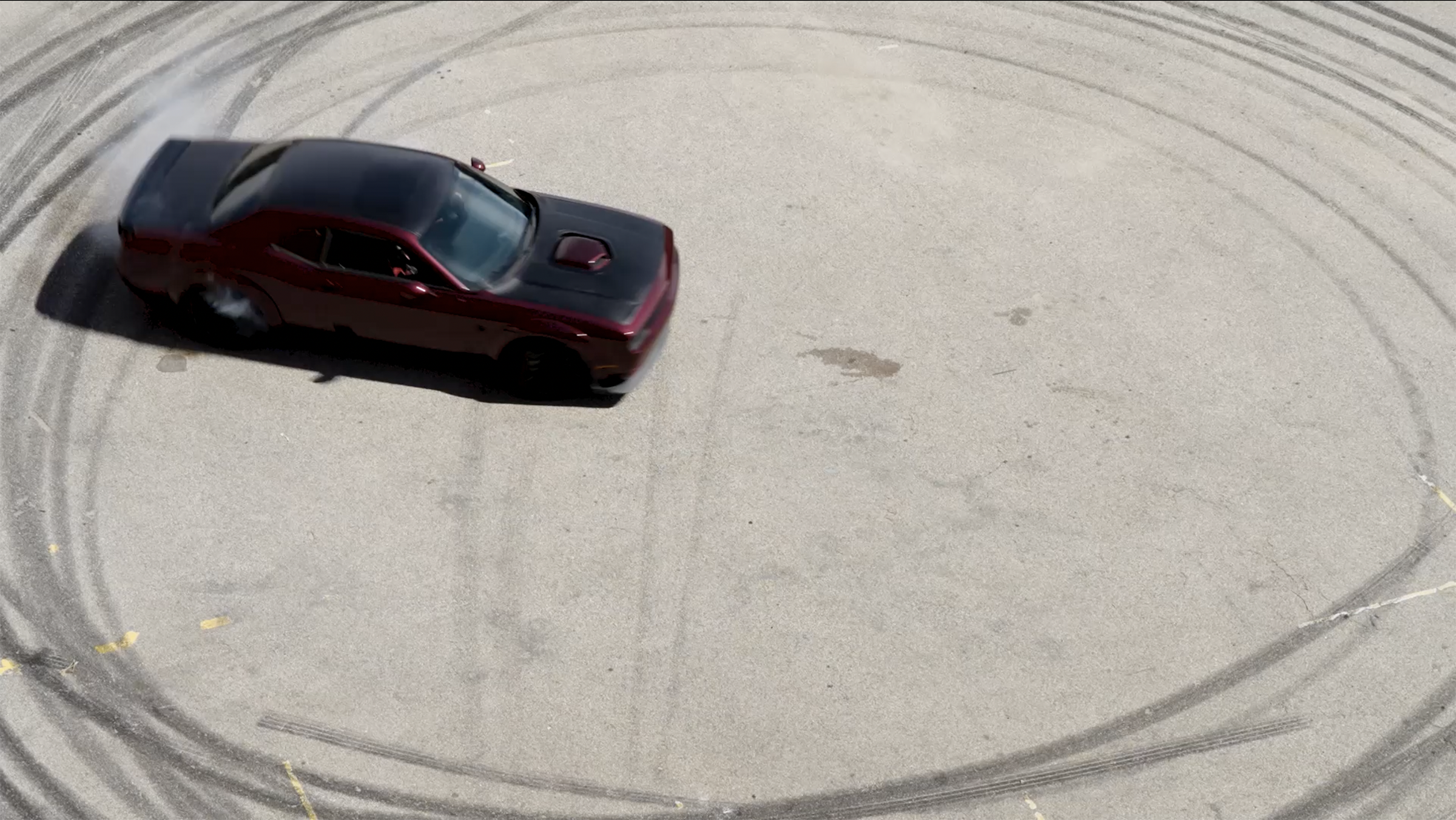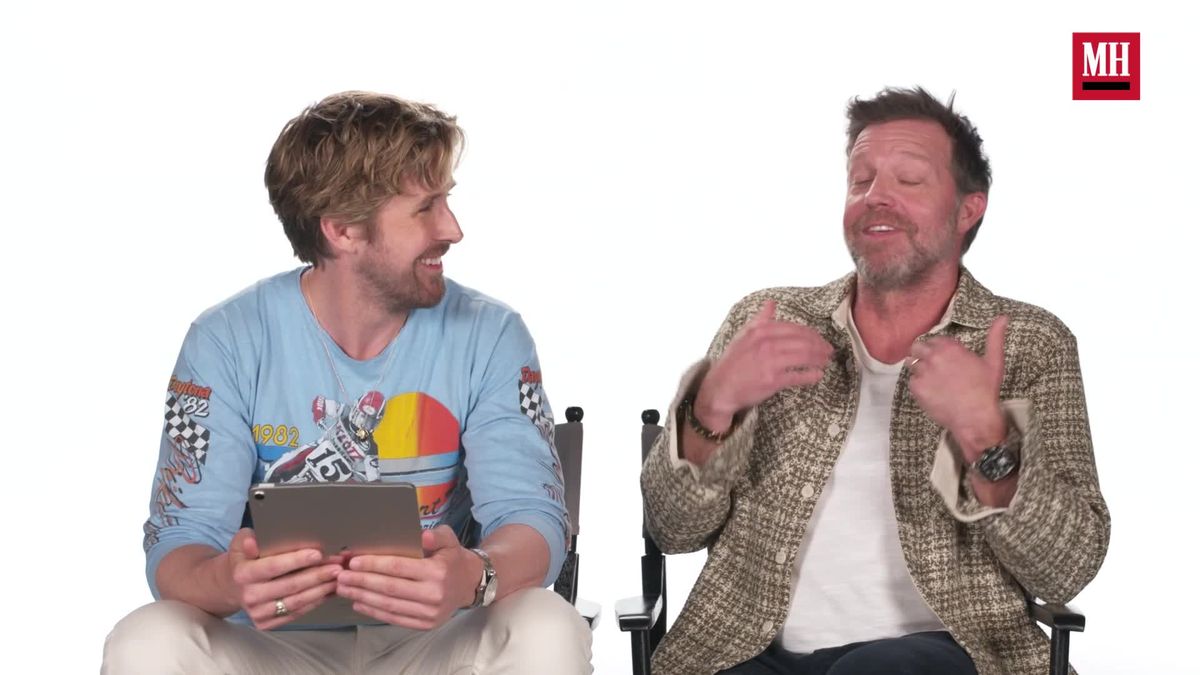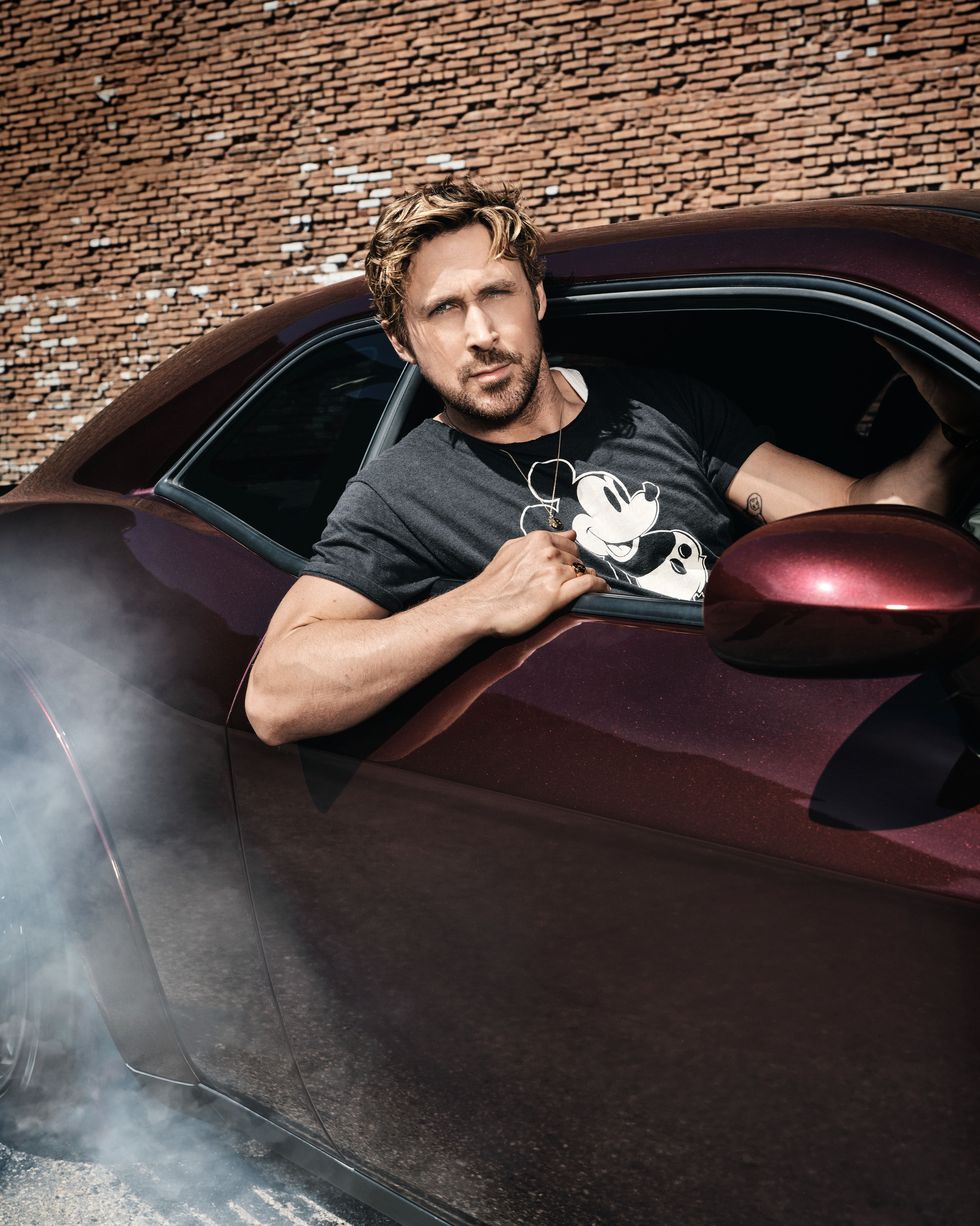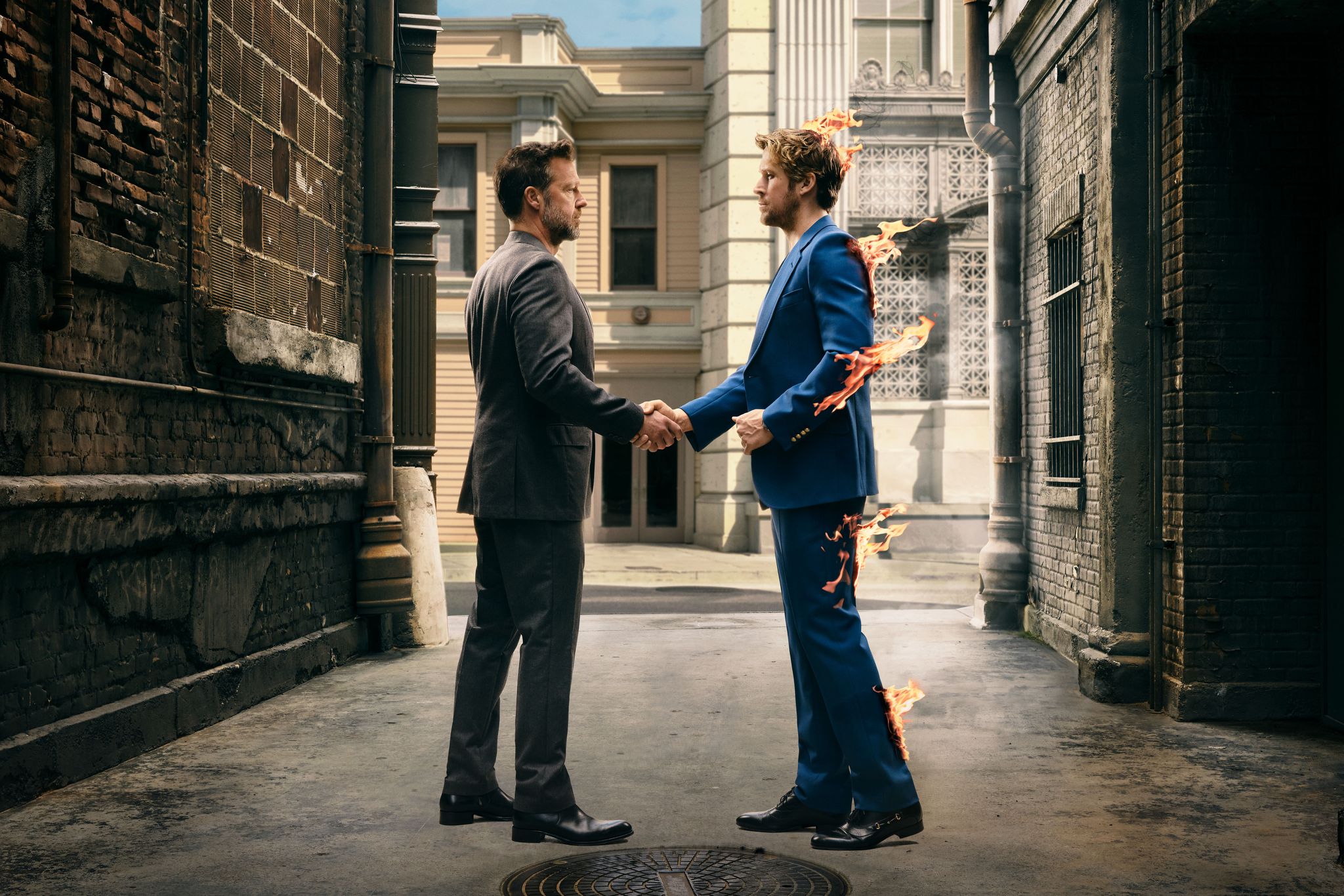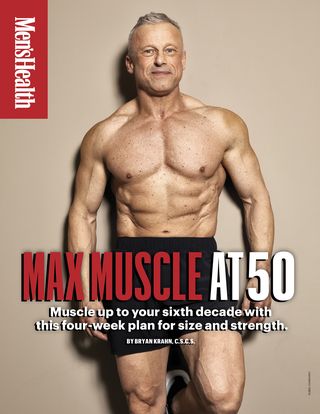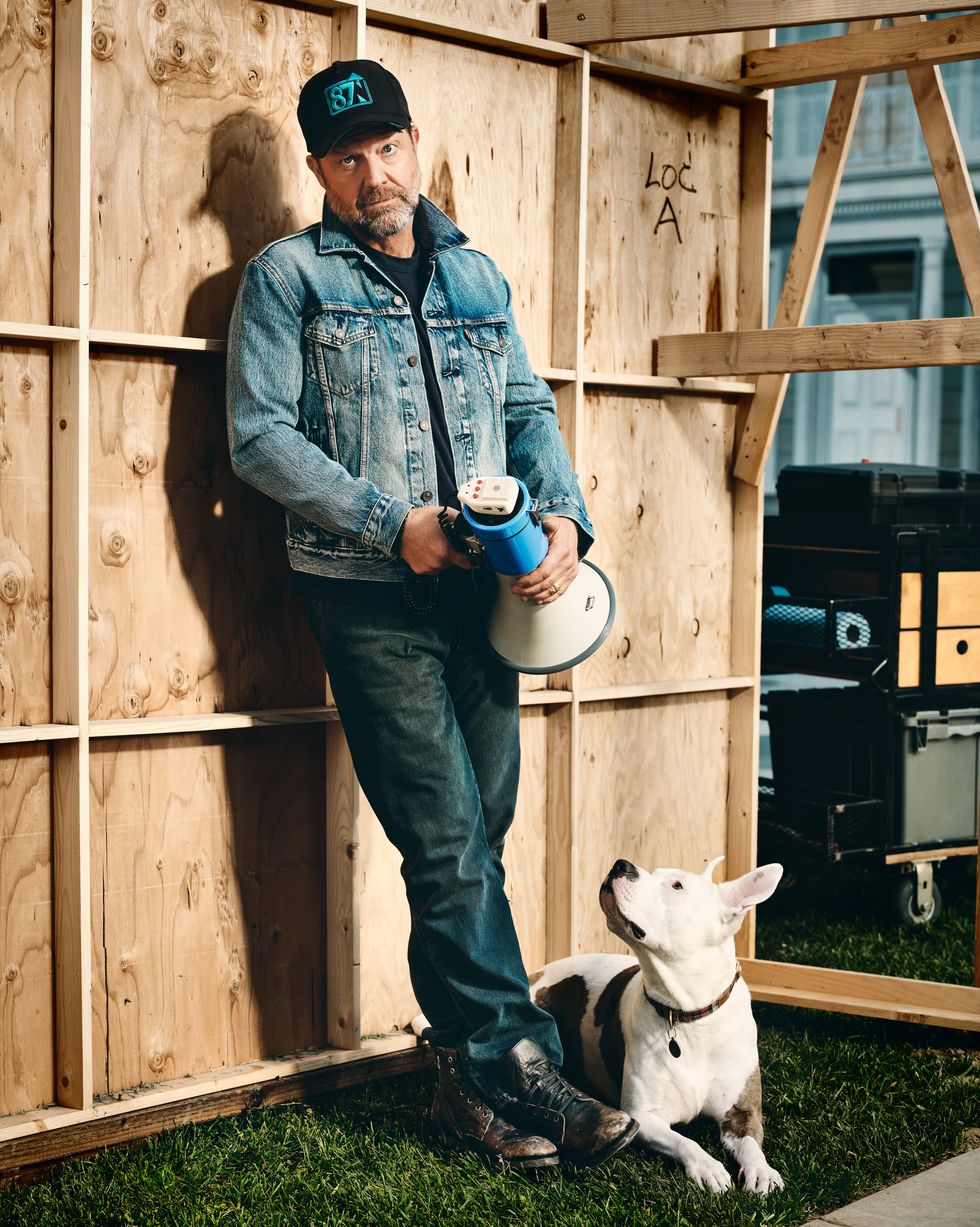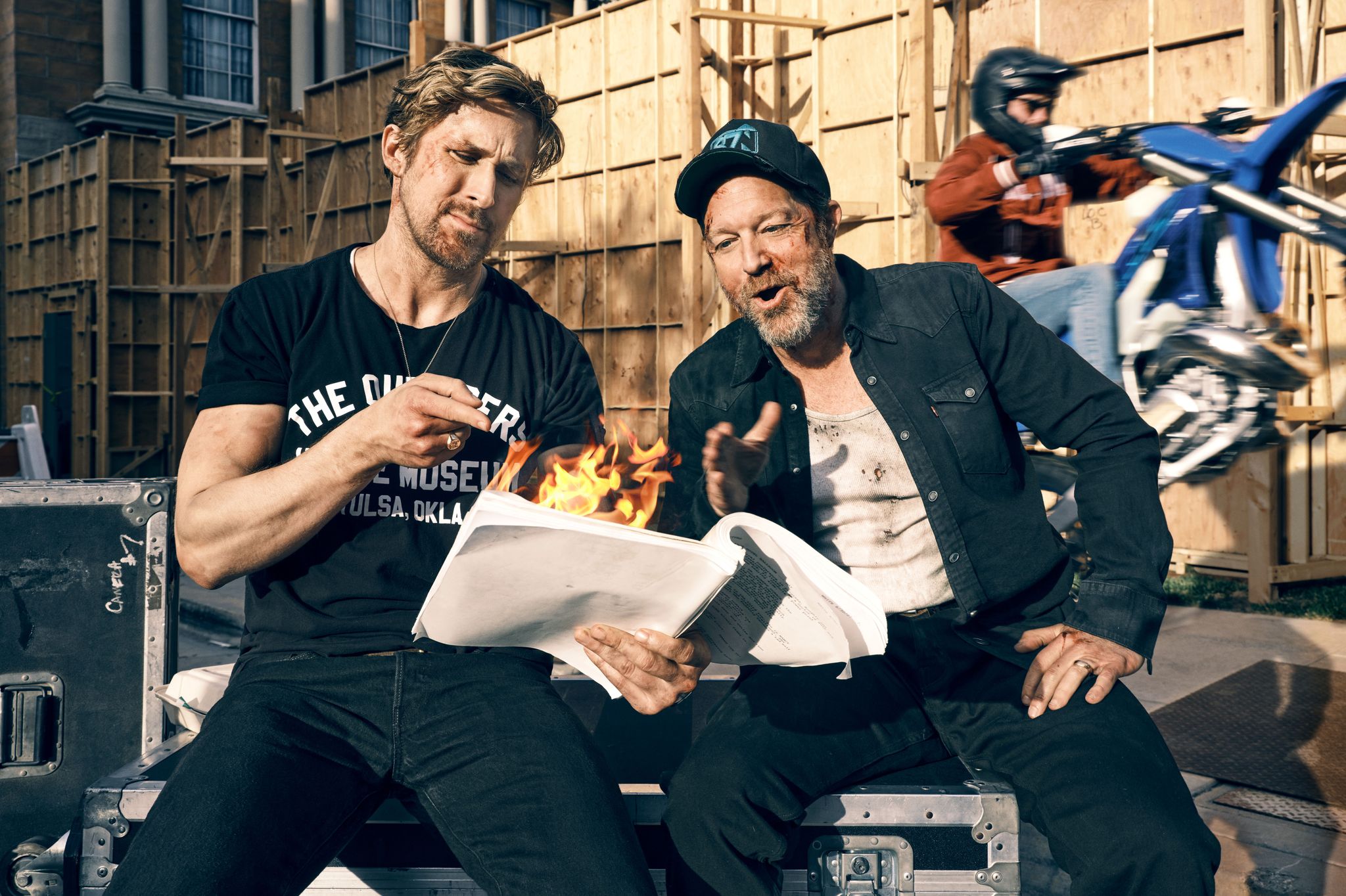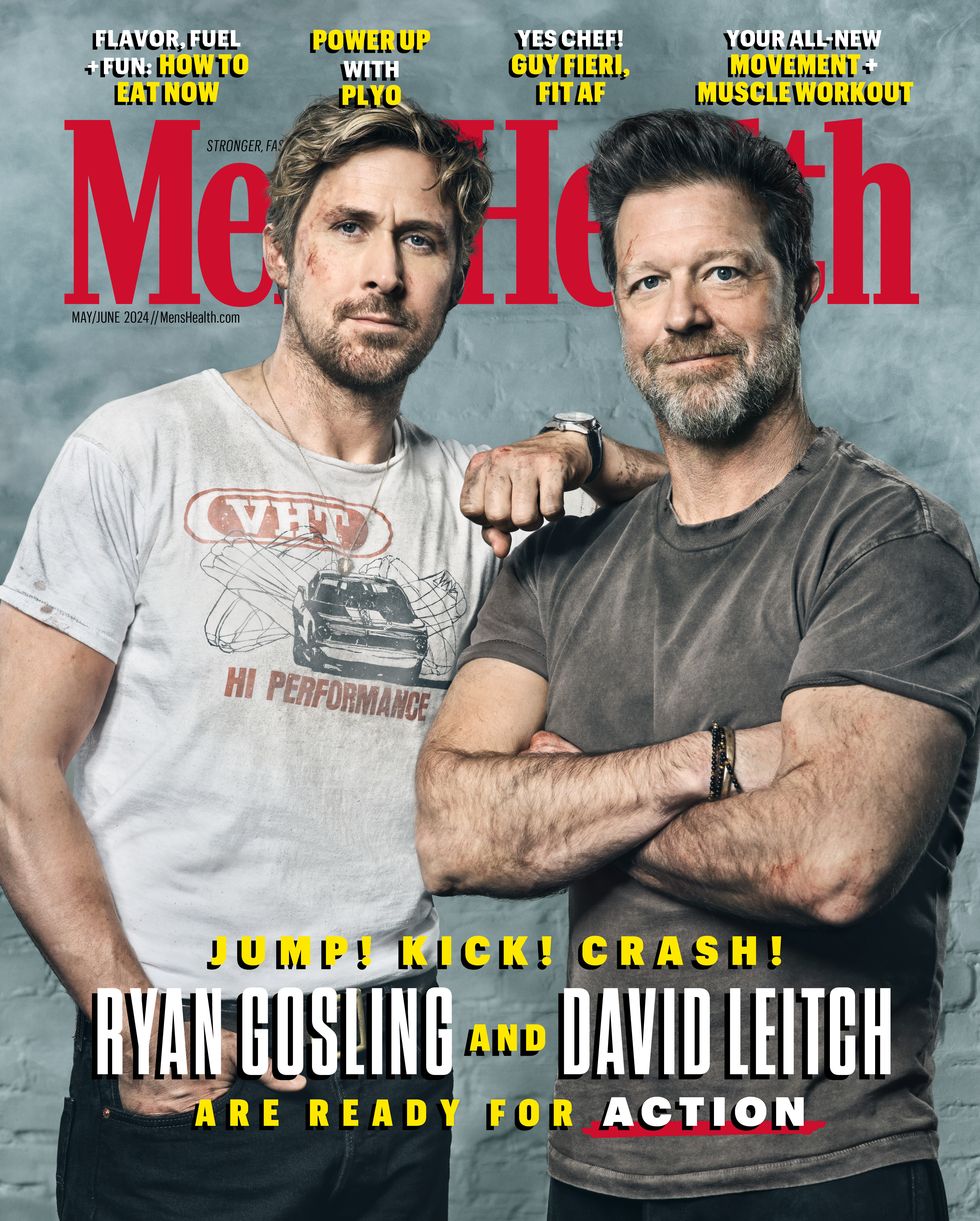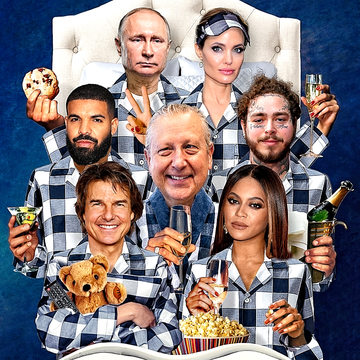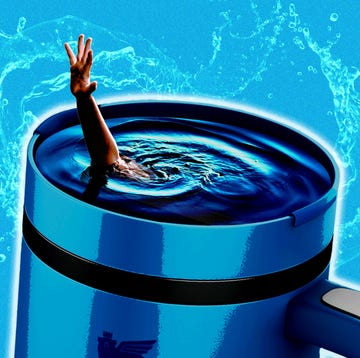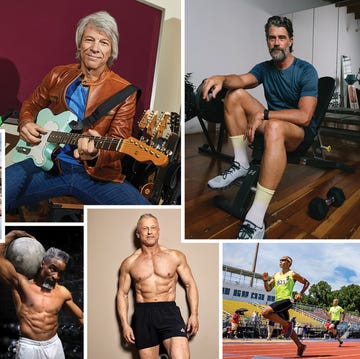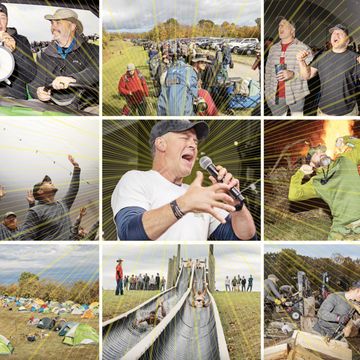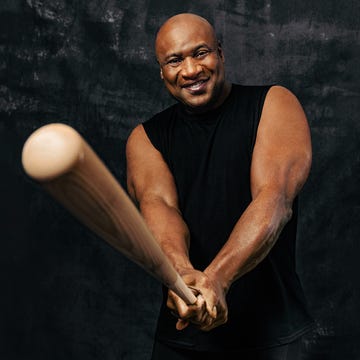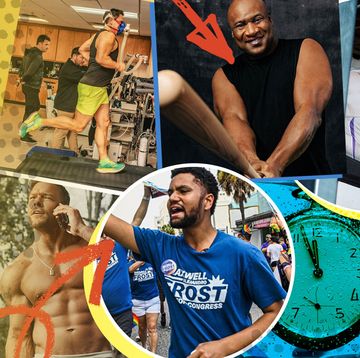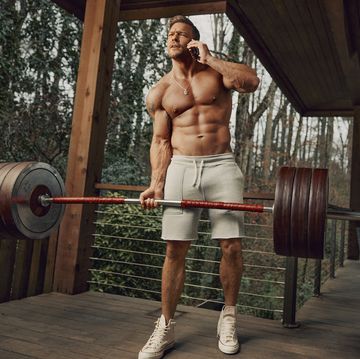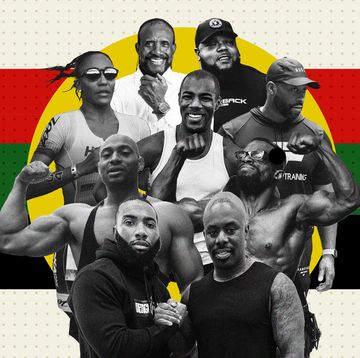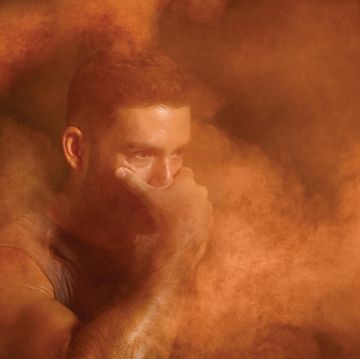IT’S A BLUE-SKY March day on the New York Street back lot at Universal Studios in Los Angeles. The acrid smoke of burning rubber wafts in the air around The Fall Guy director David Leitch and star Ryan Gosling. The reported $125 million movie drops May 3 and is loosely inspired by the ’80s TV action series about stunt performers. The smoke comes from stunt driver Logan Holladay, who is behind the wheel of a 750-horsepower Dodge Challenger SRT Hellcat. He’s spinning doughnuts around Gosling and Leitch for their Men’s Health cover shoot. The actor and director seem genuinely close, having spent six months filming the movie in Australia. “Anytime they let you burn rubber and don’t kick you out is a good day,” quips Gosling.
The 43-year-old Canadian still has the glow from another good day, when he performed his epic rendition of “I’m Just Ken” at the Oscars a week earlier. The three-time Oscar nominee (Half Nelson, La La Land, Barbie) gives off a pensive, percolating vibe—part chess grand master, part mime—with twinkling blue eyes and smile-smirk-simmer variations for days. The Mouseketeers alum says his appreciation of stunt performers dates back to playing Young Hercules as a 17-year-old. He jokes he’s had stunt doubles doing his hard work ever since. In The Fall Guy, there’s an action-movie-within--an-action-movie concept, and Gosling plays Colt Seavers, the stunt double to that movie’s star, played by Aaron Taylor-Johnson.
To create Gosling’s larger-than-life Fall Guy character, Leitch says, it actually took five stunt performers: driving whiz Holladay, primary stunt double Ben Jenkin, martial--arts expert Justin Eaton, and other specialists in jumping, falling, parkour, fist fighting, and sword dueling. Although you may not recognize the 54-year-old Leitch, you no doubt know his handiwork as a stunt double for both Brad Pitt in Fight Club and Matt Damon in The Bourne Ultimatum, as well as his fight and stunt choreography as a director ofJohn Wick, Atomic Blonde, and Bullet Train. While his movies portray stylish violence, Leitch himself oozes fun energy, is quick to laugh, and has an empathetic, gentle demeanor.
The Fall Guy is the exploding-spinning--fighting, slow-motion, split-screen sum of Leitch’s movie experience, a visual mega mix of car jumps, boat chases, helicopter hijinks, and every known kind of fighting, but throughout he focused on old-school stunt craft and minimal CGI. We may be hurtling toward a digitally created future, but The Fall Guy reminds us of the human grind that stunts demand and the physical and emotional cost of creating the mind-blowing action scenes so many of us love. MH sat down with Leitch and Gosling to talk about what’s at stake.
MEN’S HEALTH: How did your role as Brad Pitt’s stunt double in Fight Club come about?
DAVID LEITCH: I’d done journeyman stuff, Buffy the Vampire Slayer, Angel, Martial Law, a lot of television. [Laughs.]
RYAN GOSLING: A lot of awesome television! [Laughs.]
DL: Fight Club was interesting because it didn’t actually have many stunts. Jeff Imada, one of my martial-arts mentors, was the fight coordinator, and he brought me in to help train Brad to be a believable fighter. They were looking for a stunt double, and they just said, “How about this guy here?” You know, preparation plus opportunity led me to double Brad in four movies. It was a really fun time in my life. Bourne Ultimatum was one of the last movies I performed stunts in. From fights to roof jumps to getting blown backward into a parked car—it was intense. Over my career, I’ve had a few concussions and have broken my wrist in three places, torn meniscus in both knees. The usual.
MH: What was your first experience working with stunt doubles, Ryan?
RG: I did a pilot called The Unbelievables in the late ’90s. There’s a scene where I find out I have superpowers and I fly across the basketball court and I land inside the hoop. Of course I didn’t do that. But it was the first time where they brought in a double and I realized that there was this weird understanding that we would pretend they were never there and that it was you who was doing this thing. It’s a very strange dynamic that I continued a lot with Young Hercules.
DL: That’s always part of the deal. Stunt performers don’t go into it for the recognition. But we are proud of the sequences we create and how we contribute to the cinematic experience.
MH: Tell us why you two decided to collaborate on The Fall Guy.
DL: I’m a big fan of Ryan’s work. He’s hysterical in The Nice Guys. Obviously there’s Crazy, Stupid, Love; Drive; Only God Forgives. So many more. I wasn’t thinking of a particular character. I was wondering, How do we hook Ryan Gosling to make a movie? He has all these great traits. I was like, “Can we get him in the boat early so we can collaborate and make this character together using his acting superpowers?”
RG: Everything David’s done was sort of different, and there’s just such a range there that I loved. In our conversations, I felt he was coming from a place of authenticity. Fall Guy was something that really, in my mind, only he could make. The whole idea of making an action movie within the community of people who make action movies seemed so perfect—and obvious. Then, of course, David’s history as a stunt performer and as a great filmmaker. I think the bravery it takes to be a stunt performer, David brings into his filmmaking, the risks that he takes stylistically and thematically, and also being open—and immediately able—to change. That often happens with action, where you get to set and something’s not working. You have to rechoreograph high-stakes ideas with both the action sequence and the story.
MH: Ryan, you did a 12-story fall—how did that feel?
RG: I’m told that I did that, yeah—I think I blacked out for at least nine of those stories. I have a fear of heights and I knew it was coming. . . . The movie’s called The Fall Guy. We worked into the story that I would take a fall at the beginning. As we started to block it, it just felt more and more exciting to us that it be a part of this long one-take where you start in the trailer with the character, you follow him through set, up an elevator, up 12 stories, get harnessed in, and then dropped off the building. That that would be the best way to have the audience experience what a moment in the life of a stuntperson is like. It was also important for me to experience what a moment in a stunt performer’s life might be like if I was gonna play one.
DL: The idea that it was a one-er made it all the more complex—for anybody. I don’t think that there’s a stunt guy who could act as cool before [laughs] doing a four-page scene and going up an elevator and then getting hooked to a rig and then stepping off the ledge. Ryan did an incredible job!
RG: If you’ve ever seen Blazing Saddles, you know, there’s that scene where Gene Wilder says he’s totally calm [holds up a steady hand]. And then he says, “But I shoot with this hand” [holds up a shaky hand]. I had to in that moment pretend to be the coolest dude who’s fine and not afraid of what he’s doing, but I was very afraid of it. So yeah, that took a lot. I think I put sunglasses on in the scene just to hide the fear. [Laughs.]
MH: In terms of physical preparedness, Ryan, it seems like your Fall Guy body was burlier than your Ken body for Barbie. Is that fair?
RG: Yeah, that’s fair.
MH: Did you train differently?
RG: I ate more. [Laughs.] The food in Australia is just too good. And also Colt, the character, wasn’t concerned about aesthetics. You know, this was a guy who was a valet [before returning to stunt work], and one of the big selling points of his job was that he got all the burritos he could eat, so it’s not like he shows up camera ready. So yeah, it was different, and it was more fun in a way because it just felt healthier.
MH: Actors saying they do their own stunts is a recurring motif in The Fall Guy and in Hollywood. Can you unpack what that means?
DL: You know, I don’t wanna get in trouble with my friends who are actors, and I’ve worked with such incredible people who have given it up for the stunt community, but once in a while you hear the person may be trying to take all the credit or minimize the effect of what the stuntpeople are doing. I get it that it’s all part of brand management, whatever. But there’s a little bit of that that we’re making a little hyperbolic, because it’s more fun to have an antagonist who really deserves it. I’ve been lucky in my career where most of the people that I’ve doubled have never been anywhere near that.
RG: I can say from an actor’s perspective, it’s sort of a cool test when you do press; you can tell that the press want the narrative to be that you did all your own stunts or that you did many of your own stunts. That’s the cooler story, and that’s the story most people want to tell. It’s not to say that a lot of actors don’t do their own stunts; they do. I did the fall at the beginning because it was necessary to understand Colt and then a fight stunt on the Sydney Harbour Bridge, where it was important emotionally for the narrative. But my feeling lately is unless I can do it better, there’s no reason for me to do it. The stunt performers are artists, and the way that they do stunts is just so much better than I ever could.
MH: Why did you need five stunt performers to double Ryan?
DL: Because of the level of stunts we were doing, it just made sense: Let’s just bring in the best person and do something epic that celebrates stunts, whether it’s driving a boat, jumping a car 225 feet, cannon--rolling a car a world-record eight and a half times, doing practical high falls into airbags, using air ramps to do somersaults without wires. In Fall Guy, we used more stunt performers because we were trying to elevate the level of practical stunts we were doing as a celebration of our industry. Some filmmakers are inclined to want to lean toward visual effects, but my upbringing has always been practical, practical, practical—as much as possible.
MH: A scene that resonated with me for its authenticity was when Colt is talking to Jody, played by Emily Blunt, about the pain he experiences when doing stunts.
DL: Yeah, it’s personal for me because it’s something I could hear myself saying in a sense that all that stuff really does hurt. As a stuntman, you’re not allowed to say that stuff. You really aren’t. This all stemmed from conversations that Ryan and I had building the script.
RG: Yeah, that’s lifted from what you straight up said to me. We were talking about how part of this story is that Colt hasn’t been able to communicate his feelings properly to Jody. It’s part of what he’s struggling with. And I was saying to Dave, “What is the truth? Like, what is it like to be a stuntperson, really?” He was like, “Well, it hurts, you know. It all hurts. It hurts to get hit by a car. It hurts to go out a window. It hurts to get set on fire.” And then we added, you know, nothing’s ever hurt as much as not being with Jody, because that’s really what he was trying to say.
DL: You know, the whole idea of the thumbs-up [a sign stunt performers make to indicate they’re fine after a stunt] is another thing that’s related to this. Of course Colt’s not gonna tell anybody how he really feels, because you’re not ever supposed to tell how you really feel—ever. It starts on set, but it really becomes your whole life. You’re just like, “I’m good. Everything’s good.”
RG: Yeah, that’s another thing that came out of our conversations. You never really see the thumbs-down on a set. It’s always thumbs-up. It can’t always be thumbs-up, but somehow it is. Suspicious.
DL: Yeah. It can’t always be thumbs-up.
RG: And yet it is.
DL: And yet it is.
MH: Did you set out to erode the strong-silent masculine stereotype?
DL: I hope we’re shedding light on mental health—being able to express yourself and how you are really feeling is important for everybody. Definitely within the stunt community there are a lot of people that have been conditioned to just say, “I’m good.” I think it’s relatable to a lot of people, a lot of men. It’s that you have to suck it up and be stoic when really communication would’ve been a better option.
RG: Also, from the outside, it seems like it diminishes the real sacrifice and achievement when you realize that it is painful. It’s not like stunt performers don’t feel anything. It just looks that way to us. Knowing what’s really going on and what they’re putting themselves through for their art is valuable information, and it deepens these achievements and it complicates it and more honors what you’re seeing.
MH: You’ve both talked about how there should be Oscars for stunts. Why?
DL: There’s a group of us that are working hard inside the Academy to build awareness for an award. But to give clarity, we’re approaching it a lot like casting [for which there will be an Oscar in 2026]. There’s been confusion in the past where it was like, What are you going to award? Who’s the stunt? It’s not like an actor, where you’re going to award the performer. That’s important because we have some incredible performers that are doing one-off stunts, but it’s like the making of a movie—there’s an army of people in every department. We want to celebrate the department, and so the award will be for stunt design.
RG: Design is a key word. This action is designed; it’s designed in the same way that costumes are designed or a score is designed or hair and makeup or anything else. It’s not just something that just unfolds, you know, in this kind of chaotic way. So many of these sequences that are a part of cinema history and sometimes what people like most about a film or remember most were designed not by the filmmakers but by the stunt designers and the performers. It’s also impossible to separate the history of cinema with the history of action. It’s a huge part of why people fell in love with cinema in the first place. And somehow it’s been separated from the success of it and relegated to a lesser position.
MH: Do you have a favorite stunt sequence from The Fall Guy?
DL: I don’t want to name favorite stunts; that’s like naming your favorite kids.
RG: Logan’s cannon roll, where he breaks the world record [by doing eight and a half rolls on a beach], is a day I’ll never forget. I’d gotten to know Logan, and I was trying to get my head in his headspace of what he might be going through, because I was going to have to get out of that car. As Logan explains it, you know you’re going to wreck. It’s not like with the car jump, where you’re hoping you don’t wreck if you’ve planned it right. You know you’re gonna wreck this car, and not only do you know it, you’re hoping to wreck it harder and faster and in a more insane way than anyone has ever wrecked before. That’s your goal. I love that scene as well because Logan also plays the guy that puts me in the car for a stunt he’s about to do. He breaks the record and then he pulls me out of the car and pats me on the back for the stunt he just achieved! [Laughs.]
DL: It’s the best cameo in the history of film. [Laughs.]
RG: [Laughs.] Logan has done so much and acted like he’s done so little. Right there is the crux, exactly why we needed to make this movie. We can talk about it and give him full credit for what he did—and the movie and scene can still be great. I think it’s easy to turn off from a lot of action and just assume that it’s either CGI or it wasn’t dangerous. I think once you know the reality of it, suddenly there are genuine stakes.
MH: Although there are many wild stunts in The Fall Guy, the scene where Colt is fighting in the dumpster so he can get to his date with Jody, who is singing karaoke, hits really hard.
DL: Memorable stunts don’t always come from the biggest spectacle. They come from great characters that you’re rooting for and putting them in situations where they have to overcome something. With that sequence, it was a metaphor for their love story really as a whole. Colt’s physically trying to get back to her—and he’s been trying to get back to her emotionally the whole film. We’re coming up with some fun gags that work with the music and the lyrics [Jody is singing “Against All Odds,” by Phil Collins], but ultimately you’re going to remember this sequence because you’re rooting for Colt and Jody.
RG: And for it to tie in from a character perspective, too, part of the theme of the film is that stunt performers are treated as though they’re disposable. This producer thought she could just dispose of Colt in order to save the movie star because stunt performers are in some way perceived as disposable. And so to put Colt in the actual trash and to have him sort of fighting his way out of the trash was maybe a little on the nose. [Laughs.]
DL: [Laughs.] On the nose, but in a fun way!
MH: Are you worried about the future of old-school stunt movies?
DL: I think that there’s something about seeing the real stunt, like Ryan brought up, when you feel the real stakes, when it’s practical. Maybe there’ll be a point where digital and reality are indecipherable, but there’s something about a practical stunt onscreen that just delivers. At least for me, and for action fans, I don’t see it going away anytime soon.
RG: I feel the same way. What he said!
DL: And there are some stunts in my head I want to do for the Fall Guy sequel—hopefully.
MH: Zooming out, is there a motto or north star you use to help guide you?
DL: Yes, in Atomic Blonde I wanted a cool graphic in the back of the bar, and our production designer found a quote that we made into a blue neon sign and it just stuck with me: “Everything you want is on the other side of fear.” The choices that you make, it’s kind of a way to live your life, you know? I think if you want to accomplish things, you have to be fearless and know that you’re going to get knocked down and you have to get back up. It’s like a stunt guy. Fall down, get back up, fall down, get back up. You have to take these risks in your life and in your relationships to go the places you want to go.
It’s a way to put it through that prism: Is fear stopping me from doing this? Is that good fear or is that bad fear? [Laughs.] There’s certain kinds of fear where this quote doesn’t apply, but I think a lot of times it does. What you want is on the other side of fear if you’re brave enough to make the decision to go for it. That’s my philosophy for this afternoon, gentlemen.
RG: [Laughs.] Yeah, I don’t think I have a motto. I just tend to go deathbed with everything. I often think about what’s going to matter to me on my deathbed, that I did and that I didn’t do. It puts things into perspective. It always comes back to family first. I don’t think I’ll regret anything professionally, but I do think when it comes to Eva [Mendes] and the girls, they come first. I don’t know, it’s probably not a good thing that I go deathbed, but it’s helpful for me. Anytime I’m struggling, I just think about whether it’s going to matter to me then because, yeah, this whole thing can be distorting.
DL: That’s so right, Ryan; the film business can really be all-consuming.
RG: Yeah.
DL: Obviously it’s exciting. We get to create art for our lives. But it’s also just exhausting, and at some point you do have to step back and go, Am I living the quality of life that I want to live? And again, we get to do amazing things and we’re blessed, but sometimes at some point you’re like, It’s still a job. [Laughs.] That makes total sense to me. Yeah, go deathbed on it.
RG: Go deathbed on it. Yeah, are you going to care about this thing, whether you did it or not, whatever the thing is? It’s extreme, but it’s helpful.
RAPID FIRE
Favorite action movie?
RG: “I love Duel. It’s insane that it was Spielberg’s first film.”
DL: “Jackie Chan’s Police Story.”
Go-to karaoke song?
RG: “I don’t have one!”
DL: “ ‘Wanted Dead or Alive,’ by Bon Jovi.”
Last book, TV series, or podcast you recommended to a friend?
RG: “The last season of Love Is Blind. I heard the new season is even better—but I’ve been busy.”
DL: “Shōgun. Hiroyuki Sanada is amazing.”
Frenemy exercise?
RG: “Stretching. I never take time to stretch. That’s probably the thing I need to do most.”
DL: “Burpees crush everything. Burpees are hard, but willing yourself to do them is even harder than the actual burpees."
Dream partner to train with in the gym?
RG: “Bruce Lee. One of my favorite movies is No Retreat, No Surrender. Bruce appears to this kid in his mirror and trains him and teaches him how to deal with bullies.”
DL: “You can’t take Bruce Lee—he was my choice! Next would be Mike Tyson.”
Meal you cook for your partner or family?
RG: “I make a Moroccan chicken bastilla I’m not mad at.”
DL: “Simple protein, veg, and carb: grilled salmon, broccoli, and rice.”
Party fuel?
RG: “Coffee.”
DL: “Spicy margaritas!”
Heroes?
RG: “Well, Eva, obviously. And my uncle Bill. When I was in school, he said, ‘I’m gonna put all your achievements in a scrapbook.’ I didn’t want the scrapbook to stay empty. Uncle Bill believed in me at a time when I didn’t really believe in myself.”
DL: “My creative partner and wife, Kelly. We make all these movies together. I’m the director and she’s the producer, and the optics are I’m out front. But without her none of the movies would be possible creatively, technically, or logistically.”
Prop styling: Kendall Faeth.
Fashion direction: Ted Stafford.
Styling for Gosling: Mark Avery.
Styling for Leitch: Tiffani Moreno.
Styling assistance: Natasha Fomina.
Tailoring: Neli Abrahamyan.
Wardrobe distressing: Drew Talbot.
Grooming for Gosling: Lucy Halperin/Tracey Mattingly.
Grooming for Leitch: Michelle deMilt/Tomlinson Management Group.
Special-effects makeup: Gary Tunnicliffe and Hanny Eisen.
Production: Zachary Crawford/Crawford & Co. Productions.
Director/Executive Producer, video: Dorenna Newton
DP, video: Danny Dwyer
Assistant camera, video: Danny Kim
Editor, video: Elyssa Aquino
This article originally appears in the May/June issue of Men's Health.
